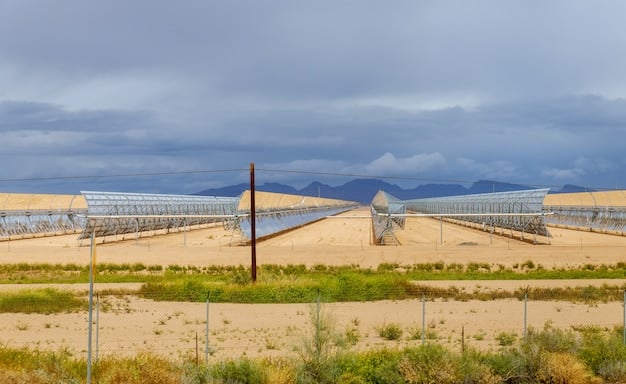Thin-Film Solar Cell Performance Analysis in US: Real-World Conditions

Analyzing the performance of new thin-film solar cells in real-world US conditions involves assessing their energy conversion efficiency, durability, and cost-effectiveness under varying climate conditions and geographical locations across the United States.
The adoption of solar energy continues to grow, and thin-film solar cells in real-world US conditions represent a promising avenue for clean energy generation. Understanding their performance nuances is crucial for optimizing deployment strategies and maximizing energy output.
Understanding Thin-Film Solar Cell Technology
Thin-film solar cells are a second-generation solar technology known for their low material usage and flexible applications. Unlike traditional silicon-based solar panels, thin-film cells are made by depositing thin layers of semiconductor materials onto a substrate, such as glass, stainless steel, or plastic.
Materials Used in Thin-Film Solar Cells
Several materials are used in the production of thin-film solar cells, each with its own advantages and disadvantages. The most common include:
- Cadmium Telluride (CdTe): Known for its high efficiency and low manufacturing costs.
- Copper Indium Gallium Selenide (CIGS): Offers high efficiency and flexibility, making it suitable for various applications.
- Amorphous Silicon (a-Si): Lower efficiency but can be produced at very low costs.
The choice of material is crucial as it directly impacts the cell’s efficiency, stability, and overall performance under different environmental conditions.
Advantages and Disadvantages of Thin-Film Solar Cells
Thin-film solar cells have several benefits over traditional silicon-based panels, including:
- Lower Cost: Reduced material usage and simpler manufacturing processes result in lower production costs.
- Flexibility: Can be applied to flexible substrates, allowing for more versatile applications, such as building-integrated photovoltaics (BIPV).
- Performance in Low Light: Performs better in low-light conditions compared to silicon-based panels.
However, there are also some disadvantages:
- Lower Efficiency: Typically, thin-film solar cells have lower efficiency compared to silicon panels, though advancements are continually improving this.
- Lifespan and Degradation: Some thin-film technologies may degrade faster than silicon panels, especially in harsh environments.
Thin-film solar cells offer distinct advantages in cost and flexibility, making them an attractive option for diverse solar energy applications. However, their lower efficiency and potential degradation issues require careful consideration.
Factors Affecting Solar Cell Performance in the US
The performance of solar cells, including thin-film technologies, is significantly influenced by several environmental and geographical factors that vary across the United States. Understanding these factors is essential for optimizing solar energy installations.

Climate Variations
The US has diverse climate zones, each presenting unique challenges and opportunities for solar energy production:
- Southwest (e.g., Arizona, Nevada): High solar irradiance and clear skies provide excellent conditions for solar energy generation.
- Southeast (e.g., Florida, Georgia): High humidity and occasional cloud cover can impact solar cell performance.
- Northeast (e.g., New York, Massachusetts): Seasonal variations in sunlight and cold temperatures can affect energy output.
- Midwest (e.g., Illinois, Ohio): Variable weather patterns and seasonal changes in temperature and sunlight pose challenges.
These climatic variations need to be considered when deploying solar technologies in different regions to maximize energy production.
Environmental Conditions
Environmental factors such as temperature, humidity, and air pollution can significantly impact the performance of thin-film solar cells:
- Temperature: High temperatures can reduce the efficiency of solar cells.
- Humidity: High humidity can lead to corrosion and degradation of solar cell components.
- Air Pollution: Dust and pollutants can accumulate on the surface of solar cells, reducing their light absorption.
Mitigating these environmental effects through proper maintenance and protective measures is crucial for ensuring long-term solar cell performance.
Geographical Location and Orientation
The geographical location and orientation of solar panels are also critical factors:
- Latitude: Affects the angle of sunlight and the amount of solar irradiance received.
- Panel Orientation: Optimal panel orientation (tilt and azimuth) can maximize sunlight capture.
- Shading: Obstructions such as trees and buildings can reduce sunlight exposure.
Proper site assessment and orientation adjustments can significantly enhance the energy output of solar installations.
Environmental and geographical factors exert substantial influence on the performance of thin-film solar cells in the US. Accounting for climate variations, environmental conditions, and geographical considerations is vital for deploying efficient and sustainable solar energy solutions.
Methodologies for Analyzing Thin-Film Solar Cell Performance
Analyzing the real-world performance of thin-film solar cells requires employing various methodologies to assess their energy output, stability, and durability. These methods provide valuable insights into how these cells perform under actual operating conditions.

Field Testing
Field testing involves deploying thin-film solar cells in real-world environments and monitoring their performance over time:
- Monitoring Energy Output: Continuously tracking the energy generated by the solar cells using data loggers.
- Performance Ratio (PR): Calculating the ratio of actual to expected energy output, accounting for environmental factors and system losses.
- Long-Term Monitoring: Assessing performance degradation and identifying potential issues over extended periods (e.g., 1-5 years).
Field testing provides practical data that can be used to evaluate the long-term viability and efficiency of thin-film solar cells.
Laboratory Testing
Laboratory testing involves subjecting thin-film solar cells to controlled conditions to evaluate their performance under specific parameters:
- Standard Test Conditions (STC): Testing under standardized conditions (25°C, 1000 W/m² solar irradiance, AM 1.5 spectrum) to determine rated power output.
- Accelerated Aging Tests: Exposing solar cells to elevated temperatures, humidity, and UV radiation to simulate long-term degradation.
- Electroluminescence Imaging: Using electroluminescence imaging to detect defects and assess uniformity in solar cell performance.
Laboratory testing provides a controlled environment for understanding the fundamental performance characteristics and reliability of thin-film solar cells.
Data Analysis and Modeling
Data analysis and modeling techniques are used to interpret the results obtained from field and laboratory testing:
- Statistical Analysis: Analyzing performance data to identify trends, correlations, and potential anomalies.
- Performance Modeling: Developing mathematical models to predict energy output based on environmental conditions and system parameters.
- Machine Learning: Using machine learning algorithms to optimize solar cell performance and predict failure modes.
These analytical methods help in refining deployment strategies and improving the overall efficiency of thin-film solar cell installations.
A combination of field testing, laboratory testing, and data analysis methodologies is essential for comprehensively analyzing the performance of thin-film solar cells. These methods provide valuable insights into the energy output, stability, and durability of these technologies in real-world conditions.
Case Studies: Thin-Film Solar Cell Performance in Different US Regions
Examining case studies from different regions across the United States provides valuable insights into the real-world performance of thin-film solar cells. These examples highlight the challenges and successes in various climatic and environmental conditions.
Southwest: High Irradiance and Clear Skies
In the arid Southwest, thin-film solar cells have demonstrated strong performance due to high solar irradiance and clear skies. Case studies in Arizona and Nevada show:
- High Energy Yields: CdTe and CIGS solar cells achieve high energy yields due to consistent sunshine.
- Temperature Effects: High temperatures can reduce efficiency, necessitating thermal management strategies.
- Dust Mitigation: Regular cleaning is essential to maintain optimal performance in dusty environments.
These findings emphasize the importance of thermal management and maintenance for maximizing energy output in the Southwest.
Southeast: Humidity and Cloud Cover
The humid Southeast presents unique challenges for thin-film solar cell performance. Case studies in Florida and Georgia reveal:
- Humidity Effects: High humidity can accelerate corrosion and degradation, requiring protective encapsulation.
- Performance Variability: Increased cloud cover leads to variable energy output.
- Material Selection: CIGS cells show good resilience in humid conditions due to their flexible composition.
Protective measures and material selection are critical for ensuring the longevity and performance of thin-film solar cells in the Southeast.
Northeast: Seasonal Variations and Cold Temperatures
In the Northeast, thin-film solar cells must withstand seasonal variations and cold temperatures. Case studies in New York and Massachusetts indicate:
- Cold Climate Performance: Amorphous silicon cells perform well in cold temperatures, maintaining reasonable efficiency.
- Snow and Ice: Snow accumulation can reduce energy production, requiring system design considerations.
- Seasonal Degradation: Seasonal temperature swings can contribute to material stress and degradation.
Material choices and system designs that account for cold climates and seasonal changes are necessary for optimal performance in the Northeast.
Midwest: Variable Weather Patterns
The Midwest experiences variable weather patterns that can impact thin-film solar cell performance. Case studies in Illinois and Ohio show:
- Cloudy Days: Frequent cloud cover reduces average energy production.
- Temperature Fluctuations: Wide temperature ranges can induce thermal stress and reduce lifespan.
- Maintenance Requirements: Regular maintenance is important to address dust and debris accumulation.
System robustness and proactive maintenance are crucial for ensuring reliable performance in the variable climate of the Midwest.
Case studies from different US regions reveal the diverse challenges and opportunities for thin-film solar cell deployment. Understanding these regional nuances is essential for optimizing solar energy solutions and enhancing their long-term viability.
Innovations in Thin-Film Solar Cell Technology
Ongoing research and development efforts are continually advancing thin-film solar cell technology, addressing existing limitations and enhancing performance. These innovations promise to make thin-film solar cells more efficient, durable, and cost-effective.
Efficiency Improvements
Researchers are focused on improving the energy conversion efficiency of thin-film solar cells through:
- Advanced Materials: Developing new semiconductor materials with enhanced light absorption properties.
- Multi-Junction Cells: Stacking multiple layers of different materials to capture a broader spectrum of sunlight.
- Surface Texturing: Modifying the surface of solar cells to reduce reflection and increase light trapping.
These advancements aim to bridge the efficiency gap between thin-film and traditional silicon solar cells.
Durability Enhancements
Improving the durability of thin-film solar cells is crucial for ensuring long-term performance:
- Encapsulation Techniques: Developing advanced encapsulation materials to protect solar cells from moisture and environmental factors.
- Protective Coatings: Applying protective coatings to mitigate corrosion and degradation.
- Stress Testing: Conducting rigorous stress tests to identify and address potential failure modes.
These enhancements contribute to the extended lifespan and reliability of thin-film solar cells.
Cost Reduction Strategies
Reducing the cost of thin-film solar cell production is essential for making them more competitive in the energy market:
- Simplified Manufacturing Processes: Streamlining manufacturing processes to reduce material usage and production time.
- Economies of Scale: Scaling up production to lower per-unit costs.
- Material Substitutions: Replacing expensive materials with lower-cost alternatives without compromising performance.
These cost reduction strategies make thin-film solar energy more accessible and economically viable.
Emerging Technologies
Several emerging technologies show promise for further advancing thin-film solar cell performance:
- Perovskite Solar Cells: Integrating perovskite materials into thin-film structures to enhance efficiency.
- Quantum Dot Solar Cells: Utilizing quantum dots to improve light absorption and conversion.
- Transparent Solar Cells: Developing transparent solar cells for building-integrated applications.
These emerging technologies have the potential to revolutionize solar energy generation with innovative thin-film solutions.
Innovations in thin-film solar cell technology are continually pushing the boundaries of efficiency, durability, and cost-effectiveness. These advancements promise to solidify the role of thin-film solar cells in the future of clean energy.
The Future of Thin-Film Solar Cells in the US Energy Market
The future of thin-film solar cells in the US energy market looks promising, driven by technological advancements, cost reductions, and growing demand for clean energy solutions. Addressing current limitations and capitalizing on emerging opportunities will be crucial for realizing their full potential.
Market Trends
Several market trends indicate a positive outlook for thin-film solar cells:
- Increasing Demand for Solar Energy: Growing awareness of climate change and government incentives are driving demand for solar energy.
- Cost Competitiveness: As production costs decrease, thin-film solar cells are becoming more competitive with traditional energy sources.
- Niche Applications: Thin-film technology is gaining traction in niche applications like BIPV, portable electronics, and flexible solar panels.
These trends suggest that thin-film solar cells are poised for significant growth in the US energy market.
Policy and Regulatory Support
Government policies and regulatory support play a crucial role in fostering the adoption of thin-film solar technologies:
- Incentives and Subsidies: Tax credits, rebates, and other incentives can make solar energy more affordable.
- Renewable Energy Standards: State and federal mandates requiring a certain percentage of electricity to come from renewable sources boost solar adoption.
- Net Metering Policies: Net metering policies allow solar panel owners to receive credit for excess energy fed back into the grid.
Continued policy support is essential for accelerating the growth of the thin-film solar market.
Challenges and Opportunities
Despite the positive outlook, several challenges and opportunities need to be addressed:
- Efficiency Gaps: Improving the efficiency of thin-film solar cells remains a key challenge.
- Material Availability: Ensuring a stable supply of rare earth materials used in some thin-film technologies is crucial.
- Public Perception: Addressing public concerns about the environmental impact of certain thin-film materials is important.
Overcoming these challenges and capitalizing on new opportunities will pave the way for widespread adoption of thin-film solar cells.
With continued innovation, supportive policies, and strategic market positioning, thin-film solar cells are set to play an increasingly significant role in the US energy landscape. Their unique advantages in cost, flexibility, and niche applications make them a valuable component of a diversified clean energy portfolio.
| Key Point | Brief Description |
|---|---|
| ☀️ Efficiency Factors | Climate and panel angles greatly affect the performance of thin-film solar cells. |
| 🧪 Material Matters | Different materials respond differently to environmental stressors, affecting overall cell longevity. |
| 📈 Economic Impact | Advancements and policy support can boost market adoption. |
| 🛡️ Longevity | Protective measures like advanced encapsulation enhance durability in harsh conditions. |
Frequently Asked Questions
▼
Thin-film solar cells are made from various materials, including cadmium telluride (CdTe), copper indium gallium selenide (CIGS), and amorphous silicon (a-Si). Each material offers unique advantages in terms of efficiency, cost, and flexibility.
▼
Climate conditions such as temperature, humidity, and sunlight intensity greatly influence solar cell performance. High temperatures can reduce efficiency, while humidity can lead to corrosion. Consistent sunlight is crucial for optimal energy generation.
▼
Thin-film solar cells are generally environmentally friendly, producing clean energy with minimal carbon emissions. However, some materials, like cadmium, require careful handling and disposal to prevent environmental contamination.
▼
Thin-film solar cells require regular maintenance, including cleaning to remove dust and debris that can reduce light absorption. Periodic inspections are also necessary to identify and address any signs of degradation or damage.
▼
Thin-film solar cells offer several benefits, including lower production costs, flexibility in application, and better performance in low-light conditions. These advantages make them an attractive option for diverse solar energy projects.
Conclusion
Analyzing the real-world performance of new **thin-film solar cells in US conditions** reveals a landscape of both promise and challenges. By understanding the nuanced impacts of climate, regional factors, and technological advancements, strategic approaches can maximize their effectiveness and contribution to a sustainable energy future.





